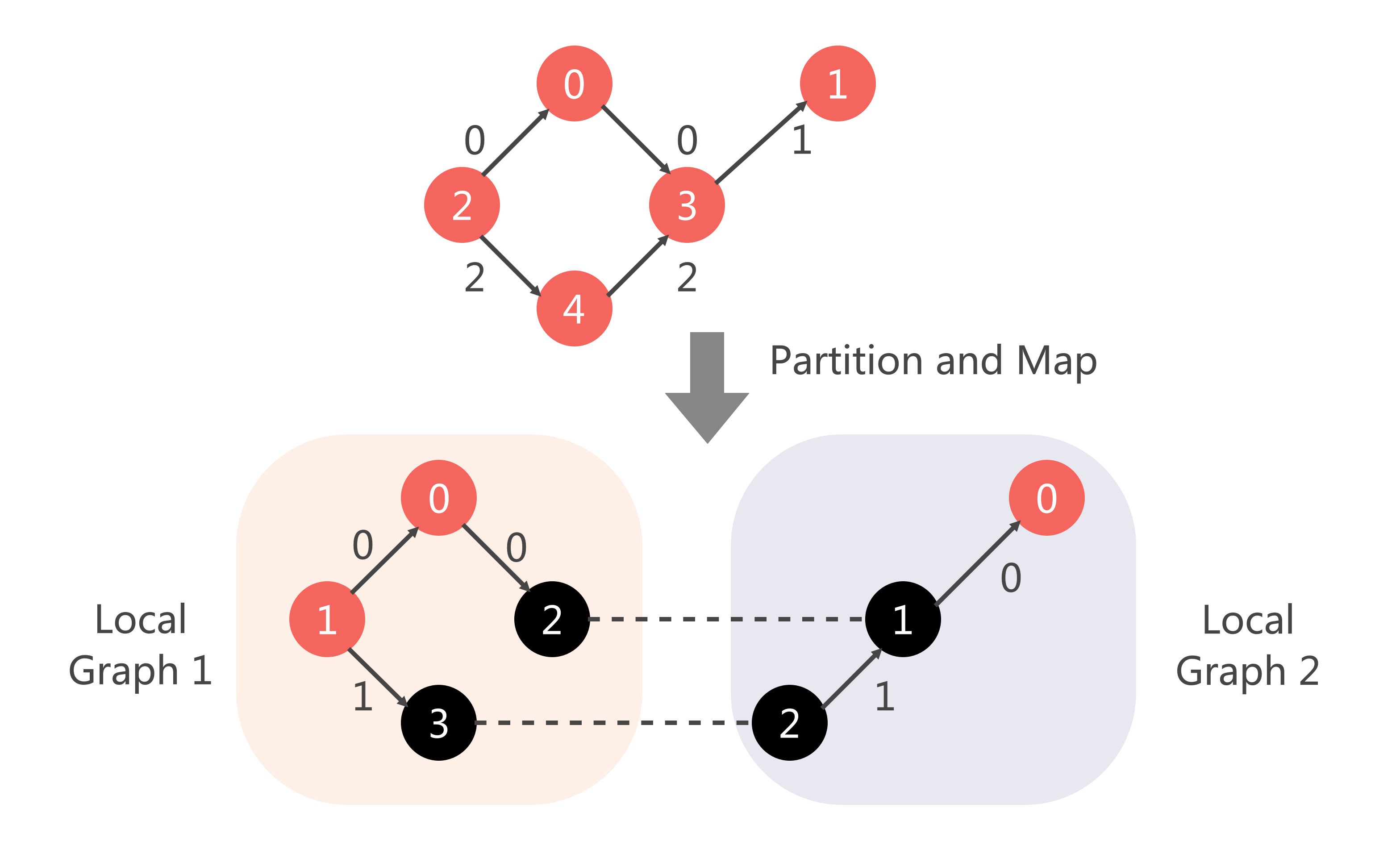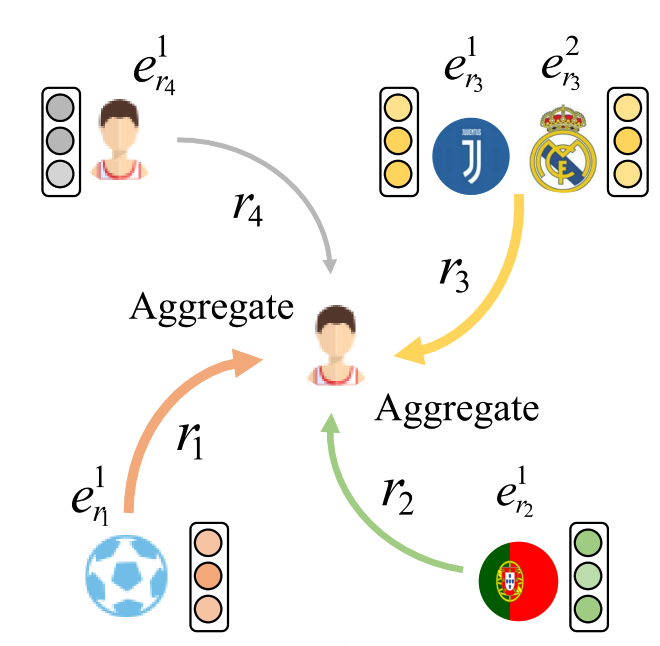联邦学习:联邦异构知识图谱数据划分
关于联邦异构知识图谱算法的完整实现代码我已经上传到了GitHub仓库:FedHKG,感兴趣的童鞋可以前往查看。
1 导引
我们在博客《联邦学习:联邦场景下的多源知识图谱嵌入》中介绍了联邦场景下的知识图谱嵌入,现在让我们回顾一下其中关于数据部分的细节。在联邦场景下,\(C\)个知识图谱\(\left\{\mathcal{G}_c\right\}_{c=1}^C=\left\{\left\{\mathcal{E}_c, \mathcal{R}_c, \mathcal{T}_c\right\}\right\}_{c=1}^C\)位于不同的客户端上。知识图谱拥的实体集合\(\mathcal{E}_c\)之间可能会存在重叠,而其关系集合\(\mathcal{R}_c\)和元组集合\(\mathcal{T}_c\)之间则不会重叠[1]。我们联系一下现实场景看这是合理的,比如在不同客户端对应不同银行的情况下,由于不同银行都有着自己的业务流程,所以关系集合不重叠。

接下来我们来看具体在实验环节怎么去划分联邦异构知识图谱数据。
2 联邦异构知识图谱划分
我们在博客《分布式机器学习:PageRank算法的并行化实现(PySpark)》中所说,分布式图数据的划分可分为点划分和边划分两种,边划分是对图中某些边进行分裂,这使得不同的worker的点不同,但可能存有相同的边拷贝。而点划分是对图中某些点进行分裂,使得不同的worker的边不同,可能存有相同的点拷贝。不过知识图谱的情况要简化得多,因为知识图谱的图数据本身就是按一条条的边(元组)\((h,r,t)\)来存储的,直接对元组进行划分其实就等价于了点划分的方式。
由于我们这里的本地知识图谱\(\{\mathcal{E}_c, \mathcal{R}_c, \mathcal{T}_c\}\)中每个知识图谱的关系\(\mathcal{R}_c\)(即边的种类)是不同的,我们在划分元组之前我们需要先对关系进行划分,然后针对关系划分的结果来划分元组。 待元组划分到本地后,还需要将原有的实体和关系的索引映射到本地索引。最后,再在本地进行训练/验证/测试集的拆分。整体数据划分流程图如下:

2.1 划分关系
我们选择随机地将关系\(\mathcal{R}\)不重叠地划分到不同的client上:
random.shuffle(triples)
# triples为元祖集合,大小为 (n_triples, 3)
# 每各元组按(h,t,r)顺序存储
triples = np.concatenate(triples)
# 先根据边的类型edge_type(即关系类型)将不同的edge_type映射到不同的client_id
edge_types = list(set(triples[:, 2]))
random.shuffle(edge_types)
edge_type_to_cid = {}
n_edge_types_per_client = len(edge_types)//n_clients
for id, edge_type in enumerate(edge_types):
c_id = id // n_edge_types_per_client
if c_id < n_clients - 1:
edge_type_to_cid[edge_type] = c_id
else:
edge_type_to_cid[edge_type] = n_clients - 1
2.2 确定元组划分
在关系的划分确定之后,我们可以根据每个元组\((h,r,t)\)中\(r\)的划分情况来决定该元组的划分情况。代码如下:
# 然后根据edge_type到client_id的映射情况,来将元组triples划分到不同的client
c_id_triples = [[] for i in range(n_clients)]
for triple in triples:
edge_type = triple[2]
c_id = edge_type_to_cid[edge_type]
c_id_triples[c_id].append(triple.reshape(1, -1))
2.3 索引映射
划分好元组之后,子图就确定了,接下来我们还需要将子图的实体和关系的索引进行重新编号,如下图所示:

对于具体的局部索引如何安排,我们采用随机选择的方式。代码如下:
# mapping global indices to local indices
c_id_triples_ori = [[] for i in range(n_clients)]
for c_id in range(n_clients):
triples = np.concatenate(c_id_triples[c_id])
c_id_triples_ori[c_id] = triples
edge_index = triples[:, :2]
edge_type = triples[:, 2]
# map entity indices to local entity indices
index_mapping = {}
entities = list(set(edge_index.flatten()))
random.shuffle(entities)
for index, entity in enumerate(entities):
index_mapping[entity] = index
f = lambda x: index_mapping[x]
f = np.vectorize(f)
client_entity_local_index = f(edge_index)
# map edge indices to local entity indices
index_mapping = {}
edges = copy.deepcopy(list(set((edge_type))))
random.shuffle(edges)
for index, edge in enumerate(edges):
index_mapping[edge] = index
f = lambda x: index_mapping[x]
f = np.vectorize(f)
client_edge_local_index = f(edge_type)
c_id_triples[c_id] = np.concatenate([client_entity_local_index, \
client_edge_local_index.reshape(-1, 1)], axis=1)
2.4 训练/验证/测试集拆分
最后,还需要在本地划分训练集、验证集和测试集。如下面的代码展示了按照0.8/0.1/0.1对本地的元组进行拆分。数据集划分完毕之后,则训练/验证/测试集对应的实体(edge_index)和关系类型(edge_type)就都确立了:
# split train, valid, test dataset
for c_id in range(n_clients):
n_triples = c_id_triples[c_id].shape[0]
n_train = int(n_triples * 0.8)
n_val = int((n_triples - n_train) * 0.5)
n_test = n_triples - n_train - n_val
mod_to_slice = {"train": slice(0, n_train), \
"valid": slice(n_train, n_train+n_val), "test": slice(-n_test, n_triples)}
for mode in ["train", "valid", "test"]:
client_data[c_id][mode]["edge_index_ori"] = c_id_triples_ori[c_id][mod_to_slice[mode], : 2].T
client_data[c_id][mode]["edge_index"] = c_id_triples[c_id][mod_to_slice[mode], : 2].T
client_data[c_id][mode]["edge_type_ori"] = c_id_triples_ori[c_id][mod_to_slice[mode], 2]
client_data[c_id][mode]["edge_type"] = c_id_triples[c_id][mod_to_slice[mode], 2]
3 关于异构性的分析和解决
根据我们前面的定义,在联邦场景下不同客户端的知识图谱满足实体重叠,因此在进行联邦训练的过程中最简单的方式就是对重叠实体的embeddings进行平均。但是我们知道,知识图谱可能本身就具有一定的异构性,因为其中的某个实体可能会拥有着不同的关系路径[2],如下图所示:

在联邦场景下这种异构性则更加明显,因为如我们前面所说,同一个实体在不同的client的关系路径肯定不同,如果只采用本地嵌入的方法,那么不同的client会映射到不同的嵌入空间。此时,如果对来自不同嵌入空间embeddings直接进行聚合,就会丢失掉许多有用的语义信息。

如上图所示[3],知识图谱School中的元组表示Bob和Jack的学业信息,Amazon.com知识图谱中则表示他们的购物信息。对于Bob和Jack实体而言,在不同的知识图谱中他们拥有不同的关系,导致了他们的语义信息在不同知识图谱中的差异。
如何对联邦场景下知识图谱的异构性进行解决,成为一个必须要考虑的问题,目前文献[3]已采用对比学习对其进行了一定程度的解决,大家感兴趣的可以去阅读一下。
参考
[1] Chen M, Zhang W, Yuan Z, et al. Fede: Embedding knowledge graphs in federated setting[C]//The 10th International Joint Conference on Knowledge Graphs. 2021: 80-88.
[2] Li Z, Liu H, Zhang Z, et al. Learning knowledge graph embedding with heterogeneous relation attention networks[J]. IEEE Transactions on Neural Networks and Learning Systems, 2021.
[3] Chen M, Zhang W, Yuan Z, et al. Federated knowledge graph completion via embedding-contrastive learning[J]. Knowledge-Based Systems, 2022, 252: 109459.

 在联邦场景下,C个知识图谱位于不同的客户端上。知识图谱拥的实体集合之间可能会存在重叠,而其关系集合和元组集合之间则不会重叠。我们联系一下现实场景看这是合理的,比如在不同客户端对应不同银行的情况下,由于不同银行都有着自己的业务流程,所以关系集合不重叠。本文我们来看具体在实验环节怎么去划分联邦异构知识图谱数据。
在联邦场景下,C个知识图谱位于不同的客户端上。知识图谱拥的实体集合之间可能会存在重叠,而其关系集合和元组集合之间则不会重叠。我们联系一下现实场景看这是合理的,比如在不同客户端对应不同银行的情况下,由于不同银行都有着自己的业务流程,所以关系集合不重叠。本文我们来看具体在实验环节怎么去划分联邦异构知识图谱数据。

 浙公网安备 33010602011771号
浙公网安备 33010602011771号